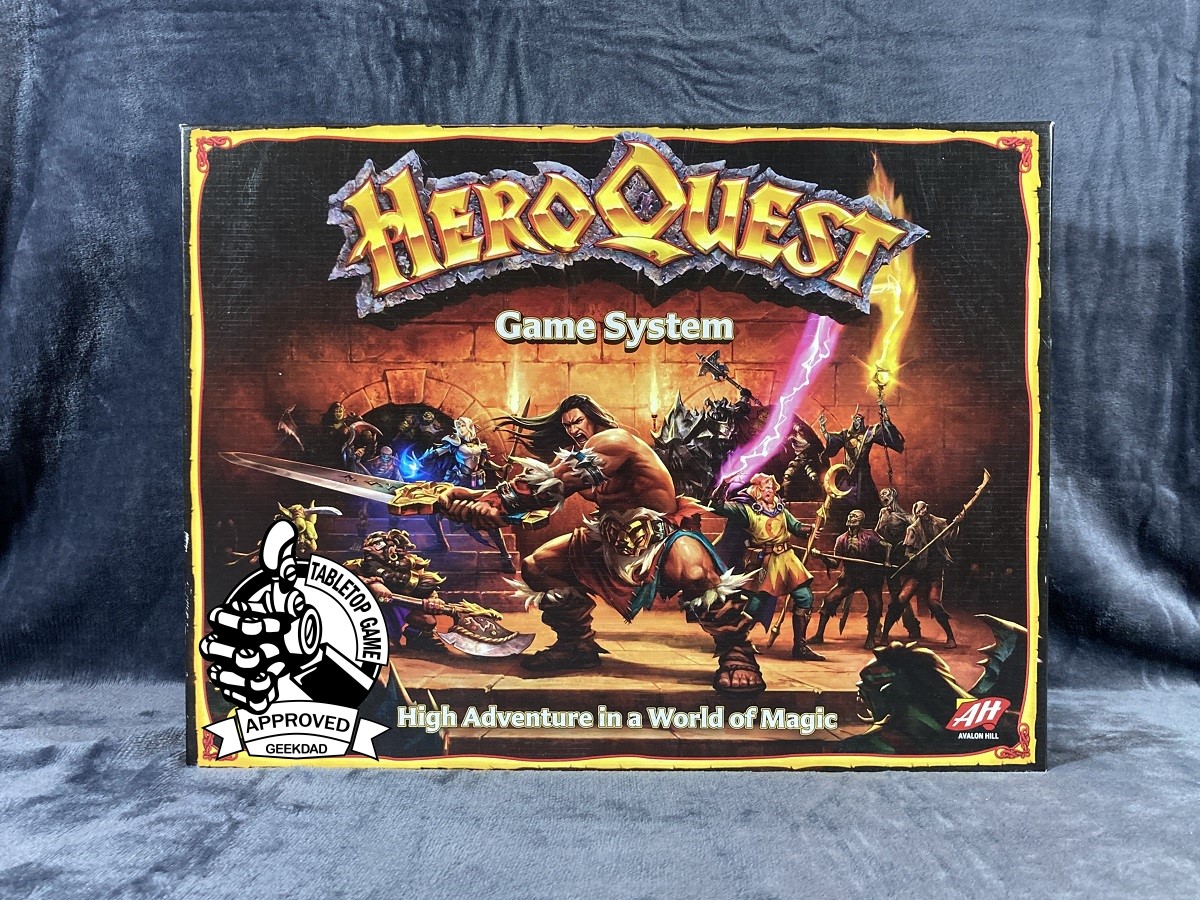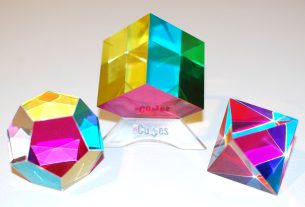In 1989, an adventure game by Milton Bradley and Games Workshop called HeroQuest began hitting tables and taking players into a fantasy world where a party of heroes delve down into dungeons, fight against many monsters, and search for treasure while completing a variety of quests. This lite role-playing game focused on action rather than complex rules and quickly became quite popular spawned several expansions in both the United States and the United Kingdom. While the game was out of print for nearly two decades, it still remained a favorite of those who still had a copy. A new generation gained access to the adventure after a successful 2020 crowdfunding campaign raised $3.7 million. By the end of the following year, HeroQuest was once again on store shelves. Since that time, there have been several expansions released as well as a free companion app.
What Is HeroQuest?
HeroQuest is a light role playing adventure game for 2-5 players, ages 14 and up, and takes about 90-120 minutes to play. One player takes on the role of Zargon, the evil sorcerer and controller of the game. The other players assume the roles of the heroes. The hero players must explore a dungeon and defeat monsters controlled by Zargon and complete the current quest. HeroQuest includes 14 linked quests. It’s currently available from your FLGS or HasbroPulse with a suggested price of $135 for a copy of the game. It can also be purchased from the Hasbro Store on Amazon and usually sells for $99 or less.
HeroQuest was designed by Stephen Baker and published by Avalon Hill and Hasbro, with illustrations by Gary Chalk, Nikki Dawes, Max Dunbar, and Les Edwards.
HeroQuest Components
Here is what you get in the box:
- 1 Gameboard
- 4 Hero miniatures
- 31 Monster miniatures
- 15 Furniture pieces
- 10 Skull pieces
- 4 Plastic rat pieces
- 21 Dungeon doors
- 93 game cards
- 4 Turn-order cards
- Cardboard tiles
- 1 Rule book
- 1 Quest book
- 4 Character cards
- 1 Game masters screen
- 1 Pad of character sheets
- 6 White combat dice
- 2 Red dice
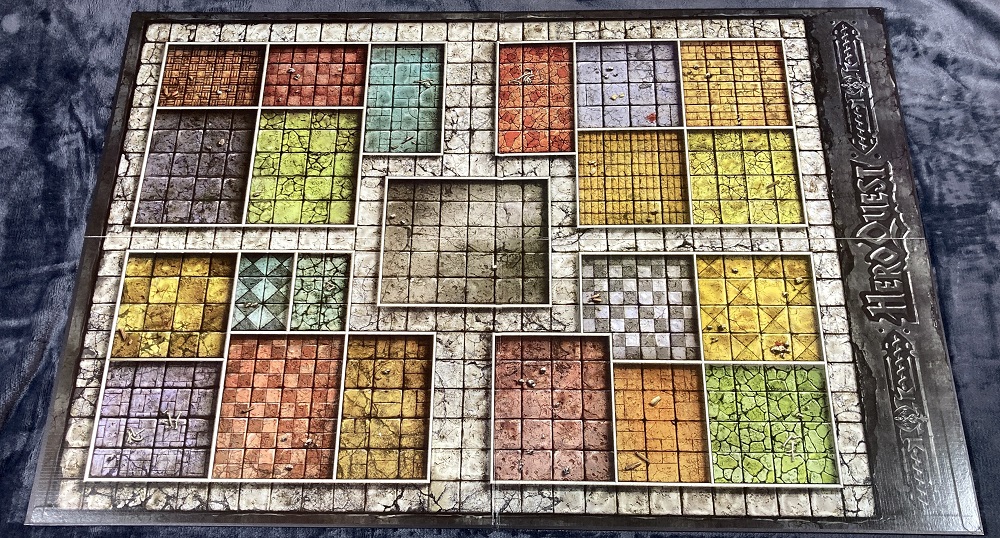
The gameboard is divided into a number of rooms and corridors. Not all parts of the gameboard are used in any quest. Instead, only some parts are used so that the same gameboard can be used for a variety of different layouts. The gameboard also features small squares which are used for movement and placement of heroes, monsters, and other features.
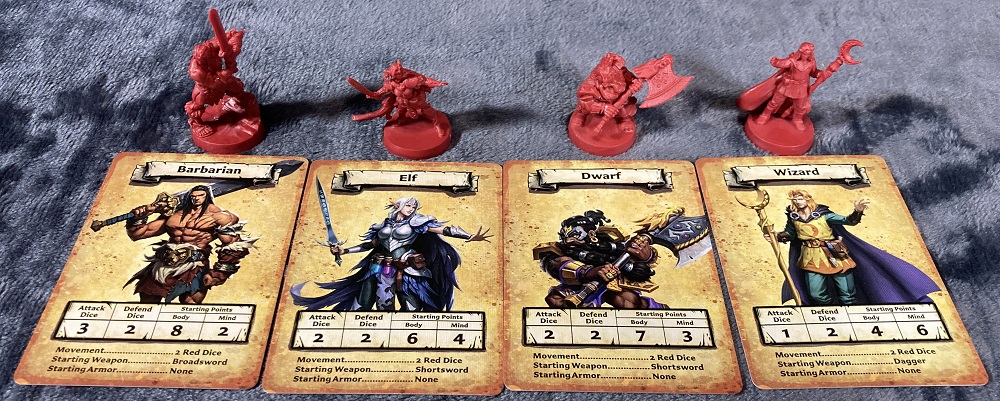
HeroQuest comes with four hero miniatures and matching characters cards. Players can choose to play as the barbarian, elf, dwarf, or wizard. Each character has different traits listed on the card. Players will copy this information onto their character sheets. While each hero has a starting weapon that determines their attack dice, they can spend gold they earn during quests to visit the armory to purchase more powerful weapons with more attack dice.

What would a quest be without monsters. The game comes with 31 minatures of monsters which include goblins, orcs, abominations, skeletons, mummies, zombies, dread warriors, gargoyles, and the dread sorcerer (which can be used for several different characters, both good and bad, depending on the quest).
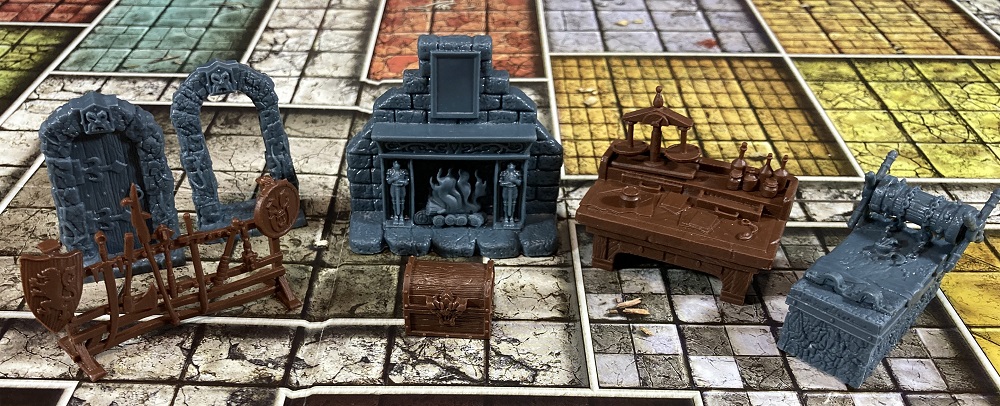
Doors are used on the gameboard to show the entrances to the various rooms. Doors almost always start closed and can be opened by the players’ characters. Once opened, a door remains opened for the remainder of the quest. Miniatures of furniture not only add decoration and ambiance to the game, but take up space in rooms and may contain treasure or traps.

Whenever a player searches a room for treasure, and there is not a specific item listed in the quest, they draw a treasure card. These can be gold which is used to purchase equipment in-between quests, an item, or possibly a wandering monster. Treasure seeking can be risky.

Artifact cards represent special items which can be found during some quests. These can be weapons or items useful to the players.

In-between quests, players may visit the armory and purchase equipment such as weapons with the gold they have found during the quests. Though each character comes with their default weapon, it is a good idea to outfit your party with improved weapons which can inflict more damage on the monsters you will face. Some items provide armor and increase a hero’s defense dice.
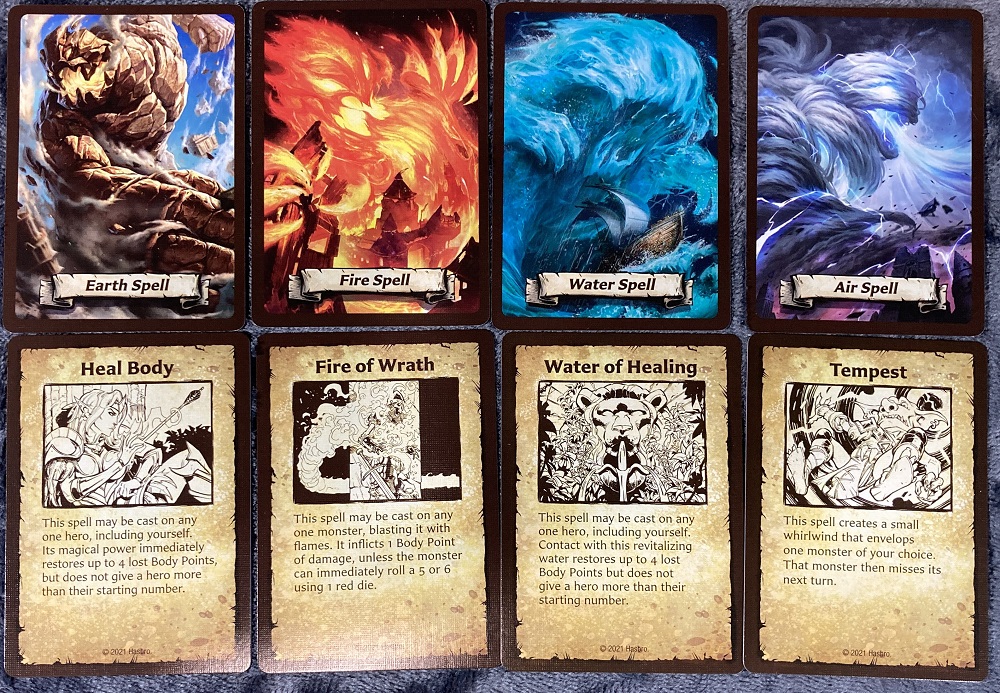
There are twelve different spell cards which are divided into four different types of spells: air, earth, fire, and water. The wizard character can have three different types of spells while the elf gets one type of spell. These spells can be cast as an action during a character’s turn. Each spell can only be cast once per quest. While most spells are not powerful, they can come in handy when situations get tough.
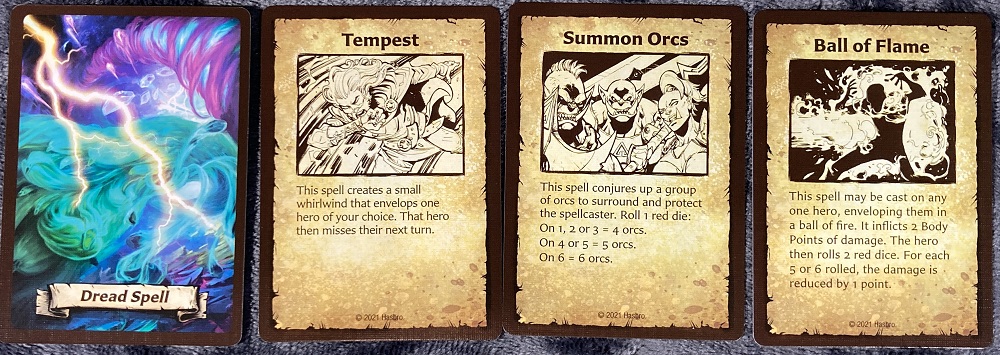
The game also includes twelve dread spell cards. These are used by Zargon against the characters. Only certain dread spells can be used as determined by each quest. Not all of them will be used with the 14 quests in the game. Some will only be used in quest packs which are sold separately or for player designed quests.
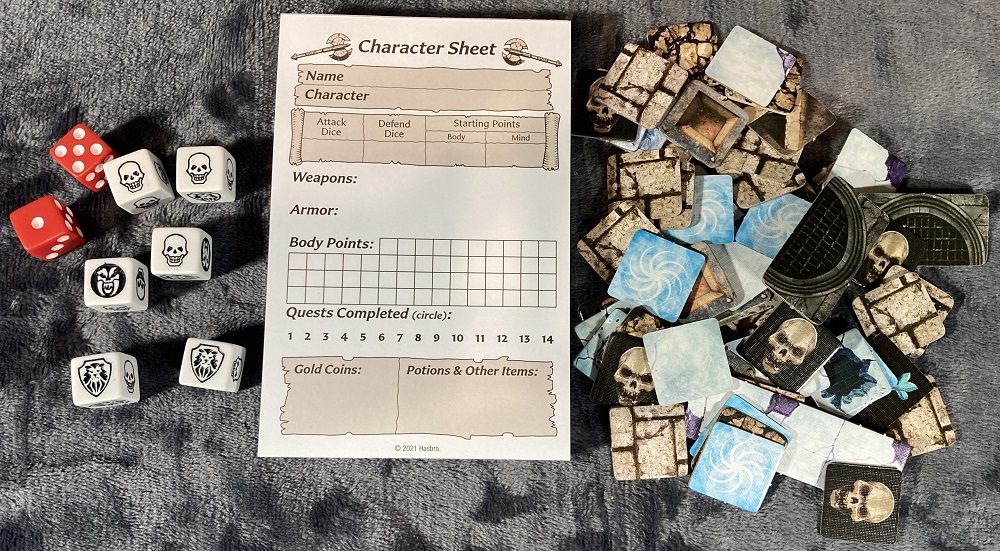
The six white dice are used by Zargon and the players for attacking, defending, and at other times to determine damage. These white dice have three symbols on them. Skulls represent damage from an attack. White shields are used by characters for defense while black shields are defense for monsters. The two red dice are used by the players to determine movement points for their character each turn. The game also includes a number of tiles to help create barriers or rooms on the gameboard as well as for traps and damage to monsters. The character sheets are used by the players to keep track of their character’s stats as well as weapons they are carrying and gold they have collected.
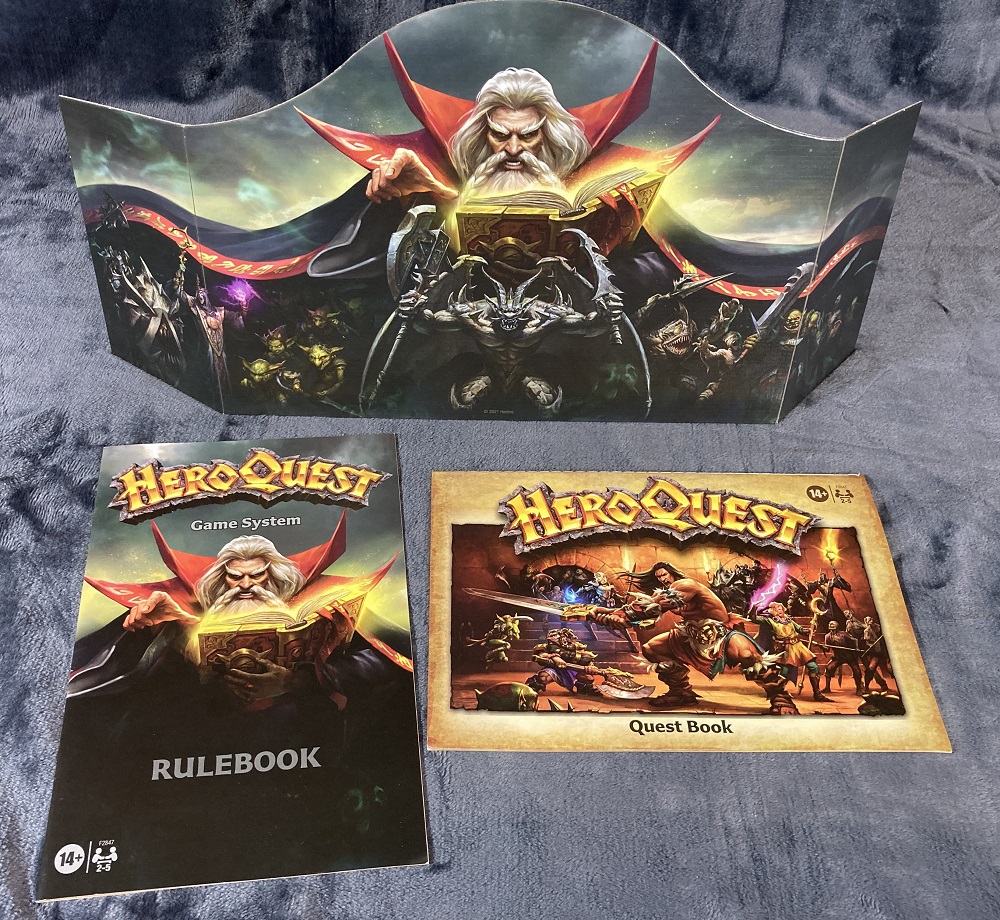
How to Play HeroQuest
You can download a copy of the rulebook here.
The Goal
The goal of the game is for the heroes to complete the goal of the current quest and exit the dungeon without getting killed.
Setup
When playing a game of HeroQuest, first determine which player will be Zargon and then the rest will take on the roles of the heroes. Zargon will setup and run the game. It is a good idea for Zargon to be familiar with the rules and to understand how the quests operate. At the start, Zargon reads the quest to themself. The hero players are not allowed to read the quest book–they are only told what Zargon can tell them.
Place the gameboard in the middle of the table. The place the character cards on the table. If this is the first quest for this group of players, the hero players each select a character card to play, then take a character sheet from the pad. They will fill in the character sheet with the information from their character card.
While they are doing this, Zargon places the game master’s screen between them and the other players. Place the quest book behind the screen and create four piles with the following; monsters, doors, furniture, and tiles. After studying the quest map, place only the tiles and items that go in the starting room. Other items will be added to the gameboard as the heroes explore the dungeon. Next sort the cards into nine separate piles: treasure cards, artifact cards, monster cards, dread spell cards, and the four groups of hero spells. The player who is the wizard, can choose one group of spells, the player who is the elf, selects another group of hero spells, and the remaining two groups go to the wizard. Place three white dice and the red dice near the heroes and three white dice go behind the screen for Zargon to use. Finally, Zargon places the the closed door and staircase in the room where the heroes begin the quest. Place the heroes on the staircase tile and you are ready to play.
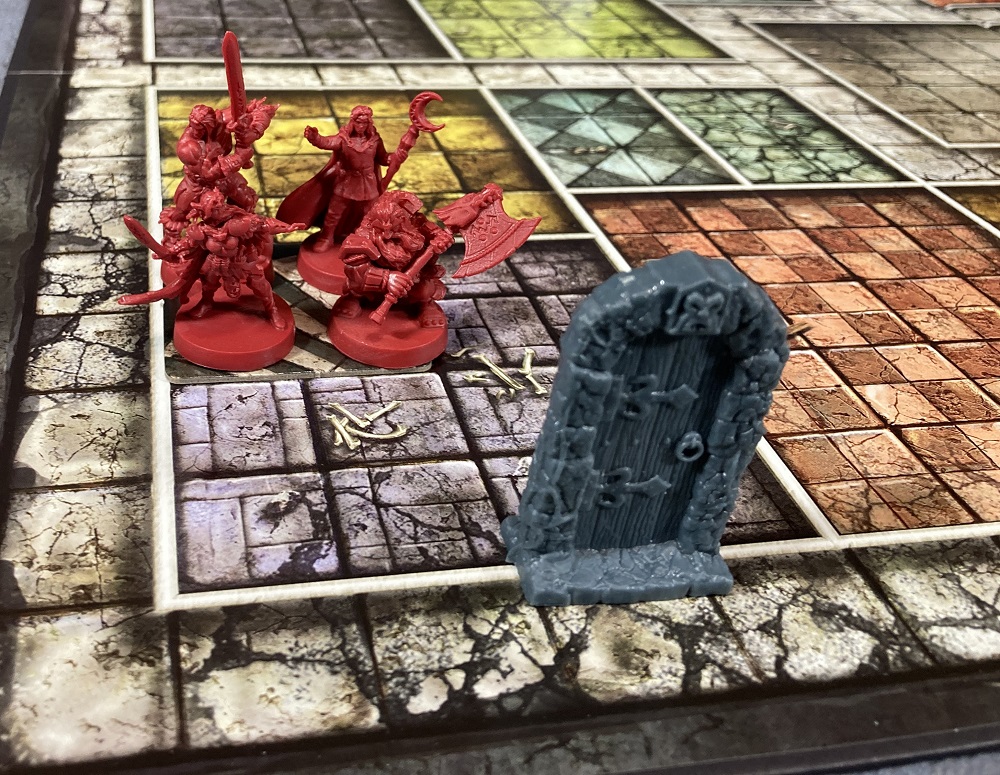
Gameplay
The game begins with Zargon reading the parchment text from the quest book to the hero players. This provides the story for the quest as well as their objective. The game is played in a series of turns. The hero seated to the left of Zargon goes first and play continues clockwise so that each hero gets to take their turn and then Zargon takes a turn. The heroes usually start in a room with a stairway which has led them down into the evil stronghold of Dread. To end a quest, they must return to this stairway.
During a hero turn, the active player can move their character and then take an action or take an action and then move their character. You cannot divide movement up with the action in the middle. To move, a player roles the two red dice and adds the two together. They can then move up to that many squares on the gameboard. They cannot move through monsters, walls, or move diagonally. They can move through other heroes, but cannot end a turn on the same square. Rooms can only be entered through doors. While moving, a player may pause their movement to look down a passageway or through an open door. A player can open a door during their movement. This does not count as an action. Once a door is open, it cannot be closed. As players move out of a room or open a door, Zargon then adds doors, tiles, and monsters that can be seen by the heroes. A closed door is replaced with an open door once opened.
During their turn, a character may take one of six actions. These include attacking a monster, casting a spell, searching for treasure, searching for secret doors, searching for traps, or disarming a trap. When attacking, a character selects a monster in range and the rolls the number of white dice determined by the weapon they are using. Each skull rolled is a hit. Zargon then rolls dice equal to the monster’s defense and for each black shield rolled, the hits are reduced by one. Any remaining damage is inflicted on the monster. If the hits equal or exceed the monster’s remaining body points, the monster is eliminated. A monster does not attack back until Zargon’s turn. The wizard and the elf can cast spells. To do they, they play one of their spell cards and resolve the effect. The spell card is then removed from the game, but can be used again in the next quest.
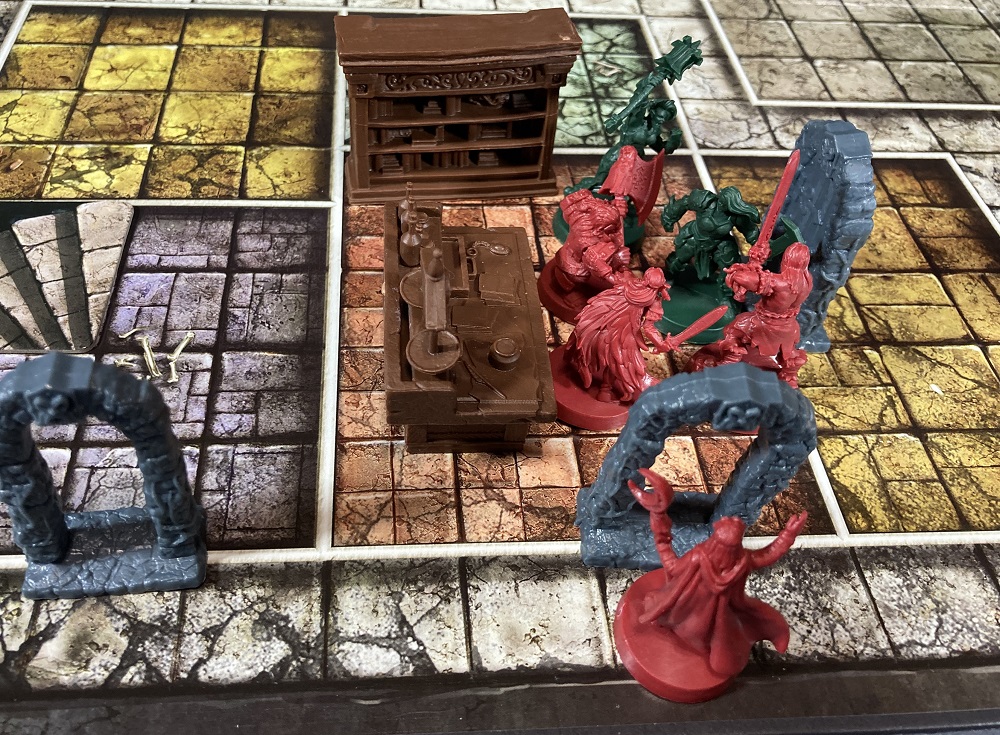
If a hero searches for treasure, Zargon will let them know if a specific result is dictated by the quest or have them draw a treasure card. This could be gold, an item, or a wandering monster. If the latter, a monster called for by the quest is placed adjacent to the hero who did the search and gets an attack against that hero. If a hero searches for a secret door, Zargon will reveal any secret doors in that room and place a tiles showing the location. When a hero searches for a trap, Zargon will inform the players of any squares in the room or corridor which have traps. However, they are not yet sprung. The dwarf or one of the other three heroes with a tool kit (which can be purchased from the armory can attempt to disarm a trap. If they are successful, the trap is disarmed. However, if they fail, the trap is sprung and they may take damage. The dwarf is better at disarming traps than the other heroes and does not require a tool kit.
After all four heroes have taken a turn, it is now Zargon’s turn. Zargon may take a turn with each monster on the gameboard. Similar to heroes, monsters can move and take an action or take an action and then move. Monsters only have two actions: attack and cast a dread spell (if they are allowed to do so). Monsters cannot open or close doors and do not spring trips. They attack similarly to heroes and roll a number of white dice equal to their attack. For each skill, they get a hit. The targeted hero then rolls white dice equal to their defense and each white shield reduces the number of hits by one. The remaining hits are inflicted on the hero who then reduces their body points accordingly. If their body points reach zero, the hero is killed unless they have a potion or spell that can restore health, then they must use it immediately to stay alive. When a hero dies, they drop any items and gold they are carrying. If another hero is in the same room, they can retrieve it by moving to that square. However, if there are no heroes in the same room, the monsters take the items and they are lost forever. Dead heroes are gone for good. However, a player can create a new hero before the next quest and start over.
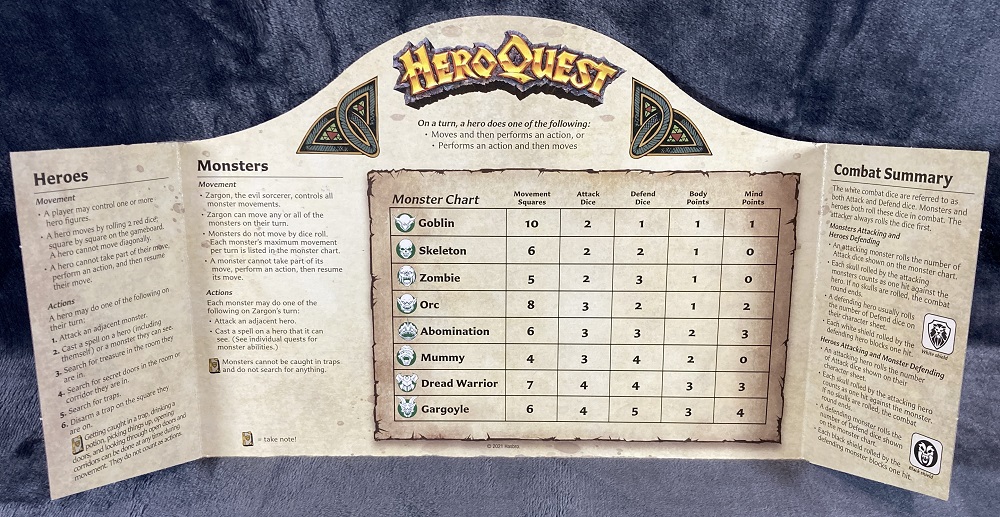
Game End
The game ends when the heroes have completed the quest goal and have returned to the safety of the stairway to exit the dungeon. There is usually a final treasure or reward for completing the quest which can be divided among the surviving heroes. Players can visit the armory and purchase equipment such as weapons to increase their heroes’ stats.
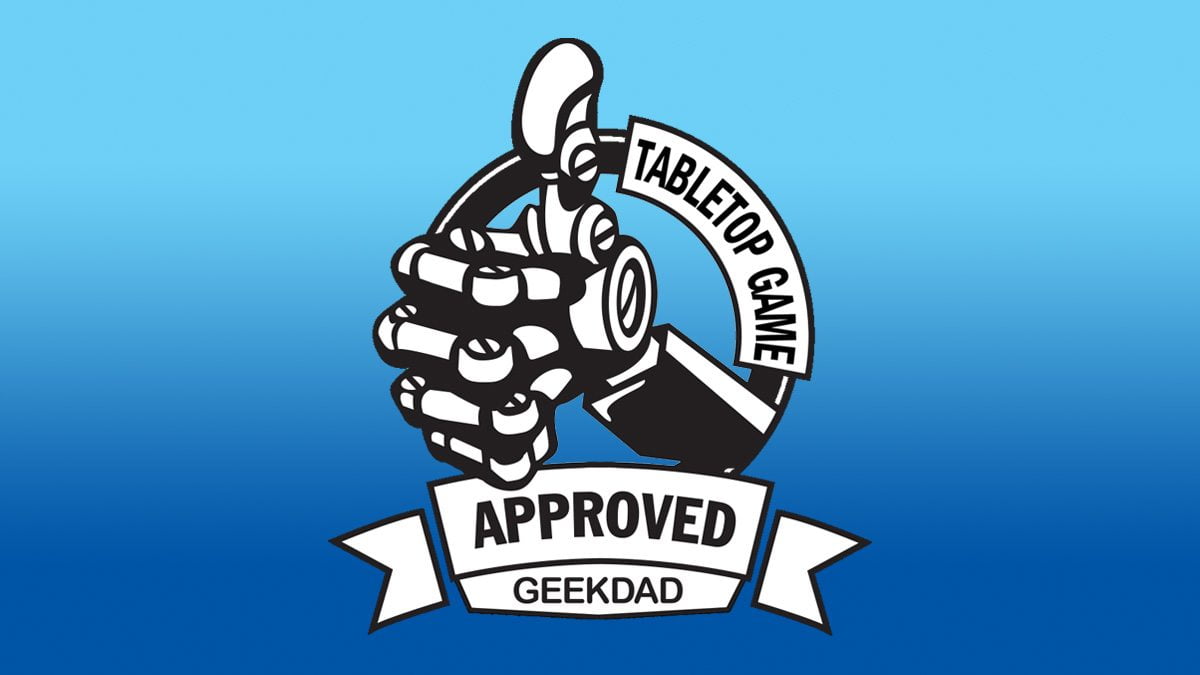
HeroQuest is GeekDad Approved!
Why You Should Play HeroQuest
I first played HeroQuest over 30 years ago at a friends house when I was in college. I liked it so much I picked up a copy at Toys’R’Us and played it with my friends and family. I still have my original copy and pulled it out about 10 years ago and introduced it to my own children. Therefore, when I learned that Hasbro was bringing back the game with improved components, I could not wait to get my hands on it. While there are a lot of dungeon crawl games that have come out over the years, many have more complex rules and require either a large investment of time to learn and play through a campaign or lack a campaign altogether and are a new start each time they are played. When I began playing it with my older children a decade ago, I thought the rules were a bit simple as compared to contemporary games. However, as I played with my children then, and now with my younger children more recently, I found that HeroQuest is just as fun as I remember it. In fact, the simplicity of the rules allows for quicker gameplay and more interaction since there is no need to constantly refer to charts, tables, and rules. The focus is on exploring, rolling dice, and defeating monsters while searching for treasure and glory. Even creating a character is quick. Choose one of the heroes, give them a name, copy the stats from the character card onto the character sheet, and you are ready to play.
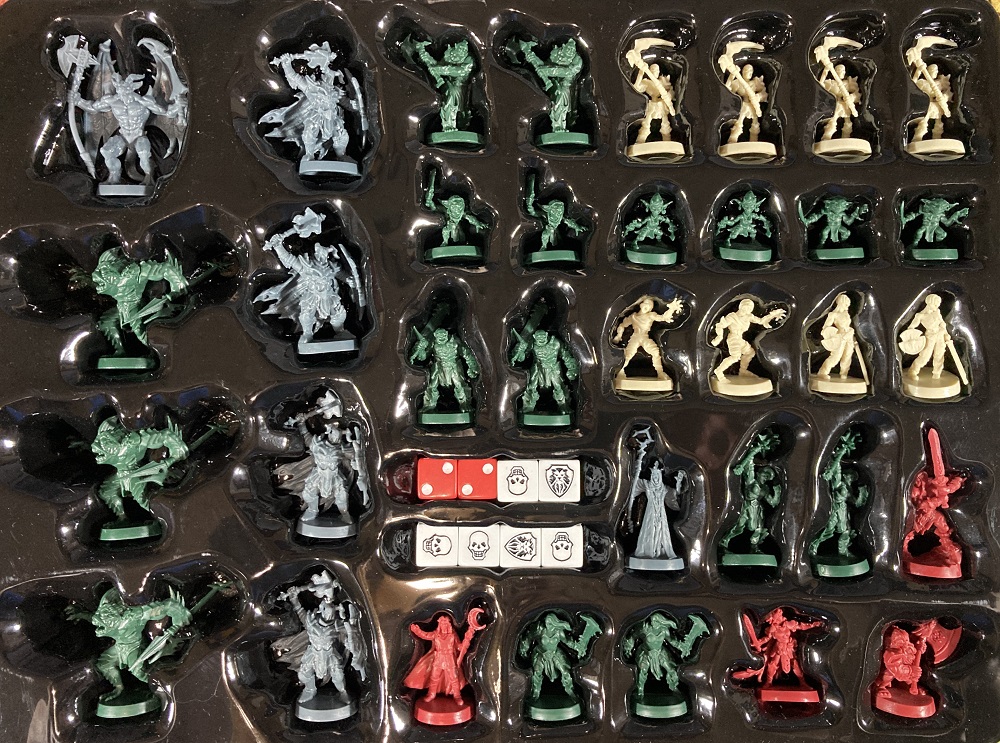
Not only is the gameplay fast, furious, and engaging, the game itself looks amazing. All of the heroes and monsters are detailed miniatures. Plus you add plastic doorways and furniture as you explore the dungeon. These too are detailed and there are even little rats and skulls you can add to them. There are tables, bookcases, chairs, weapon racks, treasure chests, and more. In fact, these three-dimensional game pieces help bring the quest to life much better than just a flat map and images or tiles. Not only does this help new players get into the game, but even veteran players love to have the miniatures.
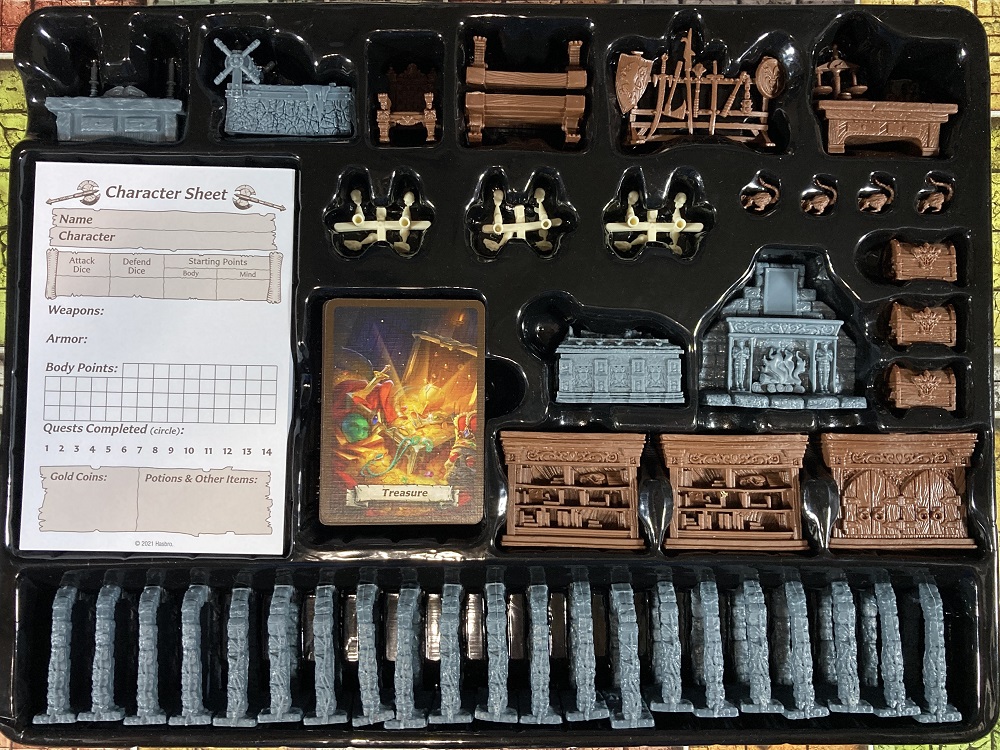
One of the fun aspects of playing HeroQuest is getting to play as Zargon. While one player can always be Zargon, a fun way to play is to take turns being Zargon. As long as you don’t read ahead in the quest book and have a good understanding of the rules, anyone can play as Zargon and essentially be the dungeon master. This also lets everyone experience exploring the dungeons and being surprised. In fact, with the HeroQuest companion app, which is available for both iOS and Android, everyone can be heroes as the app takes on the role of Zargon and even has dramatic reading of the quest texts. This also allows the game to be played solo. I have played several quests solo, taking on the role of all four heroes and really enjoyed the experience. The app is also great for new players to help learn the game. It controls all the monsters and reveals new rooms as players explore and open doors. The app not only covers the 14 quests that come with the game, it also has four new quests that were released online. Plus all of the quests from the expansion quest packs are available as well. And all of it is free! You do need to own the quest packs in order to play the quests since many have new monsters, allies, and rules. Be sure to get the companion app. It makes a great game even better. Here is a suggestion. If you are going to play a quest as Zargon, play through the quest solo with the app so you get to enjoy the exploration and surprises as the heroes, thus giving you the full experience. It also prepares you to play as the monsters since you are now familiar with the quest.
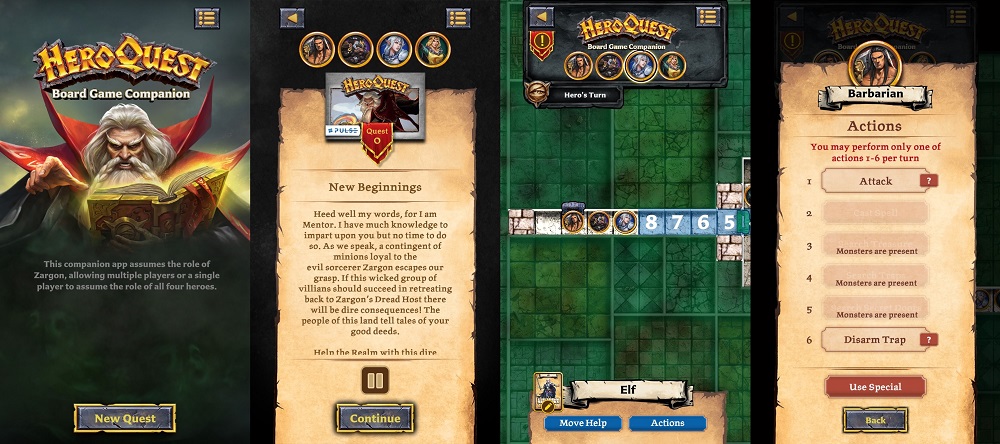
HeroQuest is not just a game, but a gaming system. As I mentioned, there are quest packs that expand the system. Currently there are five quest packs which each add a campaign of 10 quests and there are two more quest packs on the way. These quest packs add new monsters, treasure, allies, mercenaries, and even new heroes. Two additional heroes have been released which you can purchase separately: the Rogue and the Monk. Each expansion adds to the story and makes the game even better. I have previously reviewed a couple quest packs: The Frozen Horror and The Mage of the Mirror. I am currently playing through Rise of the Dread Moon and will have a review for it up shortly.
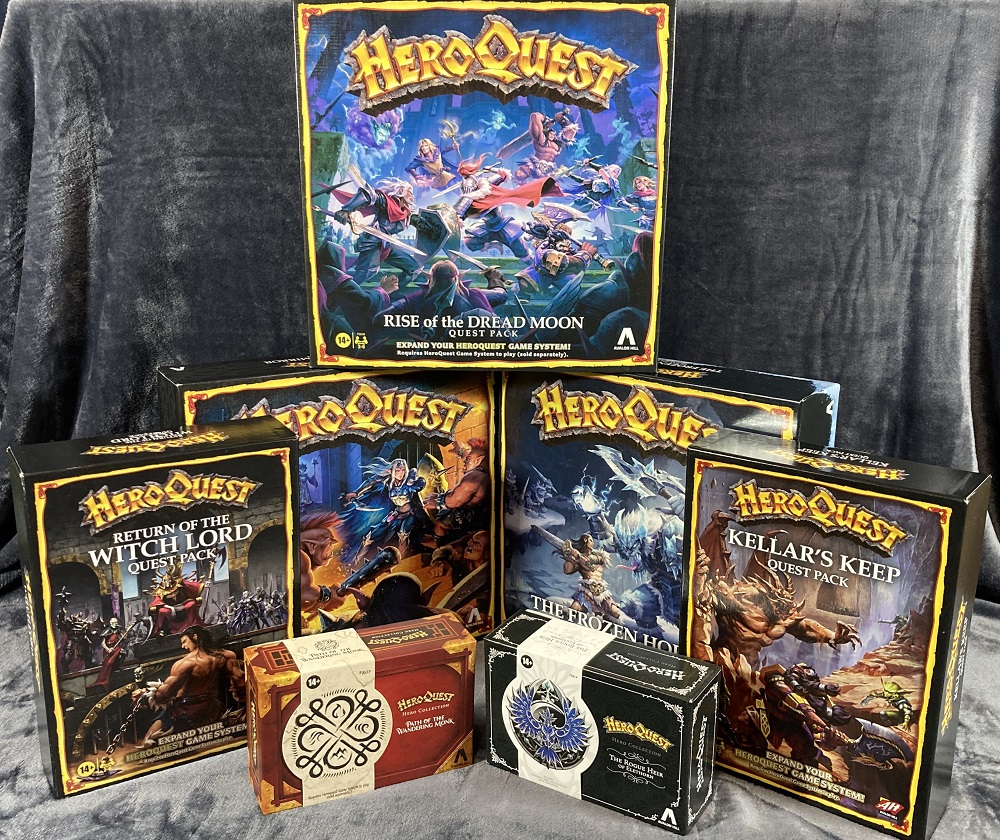
While the expansions are wonderful, the HeroQuest base game is great by itself. These quests are not always easy and they require the heroes to work together, using their individual strengths to compliment one another. The quickest way to lose a quest is for each hero to go their own way. Don’t be surprised if you have to play a few quests over again. In fact, if your health starts getting low, you may want to get the heroes back to the stairs and leave the dungeon before they are killed and lose all their items and gold. Then come back and try it again better prepared.
It is fascinating to me that a game I enjoyed three decades ago still impresses and thrills me today. When Hasbro rereleased HeroQuest, they made it even better than before. The hero miniatures have new sculpts and some monsters have several different sculpts so they don’t all look the same. The furniture is also vastly improved as well. Plus the box has a great storage system that keeps each miniature in its own little space so they are easy to get out during a game and kept safe for storage and transportation to the next game location. While some people may have viewed HeroQuest as a gateway game into role playing, I feel it is an end to itself. HeroQuest has not only survived the test of time, but is continually improving.
I highly recommend HeroQuest as a great game game to play with friends and family, or even solo. You do not have to be really into fantasy or role playing to enjoy this game. I love the look and feel of the game. I like the simplicity of setup and gameplay. As long as one player know the game and plays as Zargon, it is easy to teach new players the game. In fact, they can really learn as they play with some guidance from Zargon as to what actions are available to them. I really like the exploration aspect of the game. You have no clue what is behind a closed door until you open it. While you can improve your hero by purchasing weapons and items, they never get too powerful that quests become easy. Plus I enjoy that the game requires players to work together and delegate responsibilities. Use the dwarf to disarm traps. Keep the wizard back to cast spells and support the others. The elf can get the crossbow and attack monsters at a distance. Send the barbarian in to slash away at monsters. Finally, I have fun every time I play HeroQuest and the people with whom I play have fun as well. For me, that is one of the key things that make a great game. For all of these reasons, I have decided to name HeroQuest as a GeekDad Approved game.
For more information or to make a pledge, visit the HeroQuest webpage!
Here is a trailer for the game.
Click here to see all our tabletop game reviews.
![]() To subscribe to GeekDad’s tabletop gaming coverage, please copy this link and add it to your RSS reader.
To subscribe to GeekDad’s tabletop gaming coverage, please copy this link and add it to your RSS reader.
Disclosure: GeekDad received a copy of this game for review purposes.
